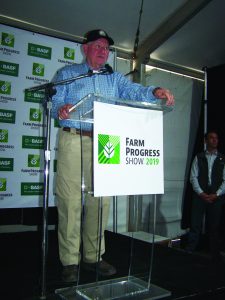R.F.D. NEWS & VIEWS: Broadband for farms, rural communities
By Tim Alexander for Chronicle Media — January 8, 2021
Outgoing U.S. Ag Secretary Sonny Perdue, pictured here in 2019, touted USDA’s accomplishments in a series of news releases and media interviews in December 2020. (Photo by Tim Alexander)
Broadband for farms, rural communities
At year’s end, outgoing USDA Secretary Sonny Perdue took a media victory lap to highlight the many accomplishments achieved by his agriculture department. His stops included an interview with the Illinois Farm Bureau’s Rita Frazier on RFD Radio (not affiliated with this column), where Perdue summarized USDA’s notable 2020 achievements in a chat aired on Dec. 30. Under Perdue, USDA’s achievements were indeed commendable. The following is a summary of said achievements, based on USDA news releases and Perdue’s statements:
COVID-19, weather and wildfires
“While this was a tough year with the coronavirus, historic wildfires, and weather damage, USDA met these challenges with a multitude of programs and services to support Americans and keep our agricultural sector running and responsive to the country’s needs,” said Secretary Perdue. “We salute our mission areas and agencies for keeping our customers front and center, serving the American people, farmers, ranchers, foresters, and producers.”
Perdue lauded the department’s response in helping farmers and ranchers receive two rounds of Coronavirus Food Assistance Program funding during 2020 by working with the Office of the Chief Economist and other agencies. He also extolled USDA’s Food and Nutrition Service for taking unprecedented steps to ensure that children and low-income Americans had access to nutritious food during the pandemic.
“USDA will be expanding our free school meal program to make these meals available to all children throughout the entire 2020-21 school year as part of our commitment to ensuring all children across America have access to nutritious food as the nation recovers from the pandemic,” Perdue stated.
Farmers to families food box program
Perdue also highlighted the USDA’s Agricultural Marketing Service, which purchased $8.6 billion in food for delivery to food banks, churches, schools, community organizations, tribal organizations, and international food aid organizations through various programs during Fiscal Year 2020. Utilizing CFAP funding, USDA announced the Farmers to Families Food Box Program in April. USDA aligned with national, regional and local distributors, whose workforces have been significantly impacted by the closure of food service businesses, to provide some $4.5 billion in fresh fruits and vegetables, dairy products and meat products purchased from American producers. Distributors packaged the products into family sized boxes and transported them to food banks, community and faith-based organizations, and other nonprofits serving Americans in need. The program has provided more than 125 million food boxes to Americans in need, according to the USDA.
Broadband for farms, rural communities
During his interview with RFD Radio’s Rita Frazier, Perdue spoke of USDA’s continuing effort to improve rural broadband access and reliability. During 2020, USDA invested $1.3 billion to support rural broadband expansion through the ReConnect Pilot Program. Included in this total was $85 million provided through the CARES Act. In total, these investments are connecting approximately 280,000 households, 19,978 farms and 10,053 businesses to high-speed internet.
USDA stimulated innovation
Through USDA’s much-discussed Agriculture Innovation Agenda, the department committed to stimulate research innovation in an effort to increase U.S. agricultural production by 40 percent, while cutting the environmental footprint of U.S. agriculture in half, by 2050. The initiative, composed of four main components, seeks to develop research strategies; align the work of “customer-facing” agencies and integrate innovative technologies and practices into USDA programs, while setting benchmarks to track progress toward meeting future food, fiber, fuel, feed and climate demands. As one example of Agriculture Innovation Agenda efforts, USDA, the U.S. Environmental Protection Agency and the U.S. Food and Drug Administration are working together to deliver on the U.S. national goal of reducing food loss and waste by 50 percent by 2030 through consumer education, food date labeling, measurement, and collaboration with private businesses.
Rural economy boosted under Trump’s USDA
Perdue was not the only top USDA official calling attention to the achievements of the department in 2020. On Dec. 16, USDA Deputy Under Secretary for Rural Development Bette Brand touted the success of programs she said helped strengthen the nation’s rural businesses and communities.
“Under the leadership of President Donald J. Trump and Agriculture Secretary Sonny Perdue, USDA invested a record $40 billion in rural communities in 2020,” Brand said. “This assistance is helping increase economic opportunities and improving the quality of life for rural residents across the 50 states and all U.S. territories.”
Brand added: “USDA responded with urgency to help those affected by the COVID-19 global pandemic. We worked to bring high-speed internet capacity, modern community facilities, and upgraded water and wastewater infrastructure to rural areas. We helped provide homeownership opportunities and reliable electricity. We invested in businesses and family supporting jobs, because when rural America thrives, all of America thrives.”
Conservation delivery continued amid pandemic
USDA’s Natural Resources Conservation Service assisted with disaster relief programs during the early phases of the COVID-19 pandemic. In addition, NRCS continued to deliver conservation services during the outbreak using social distance guidelines, phone and online tools. In 2020, NRCS worked with producers and communities to develop more than 100,000 conservation plans. NRCS co-invested $1.32 billion through the Environmental Quality Incentives Program to put conservation practices on 10 million acres, as well as $507 million through the Conservation Stewardship Program to put conservation enhancements on 9.3 million acres. The agency enrolled more than 430 new easements, totaling 230,000 acres, into the Agricultural Conservation Easement Program, and entered into over 420 agreements with local sponsors to cooperatively implement emergency recovery measures through the Emergency Watershed Protection Program. (USDA news release)
Illinois Farm Fact:
In FY 2020, USDA’s Food Safety Inspection Service inspected more than 166 million head of livestock and 9.68 billion poultry carcasses. (USDA news)



